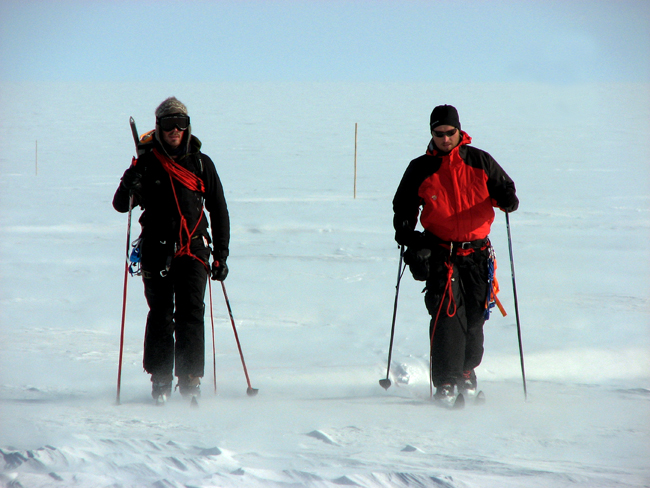|
CReSIS to mold new modelsNSF-funded Science and Technology Center develops latest technologies to measure ice sheet massPosted January 24, 2008
Related Stories The story about how climate change is affecting ice sheets in the polar regions is a familiar one by now. But the plot still has plenty of mysteries, foremost among them being the rapid loss of mass from the ice sheets in Greenland and Antarctica. The ice sheet models just don’t gel with current observations, particularly in the Arctic. One of the key protagonists in this unfolding story for the next five to 10 years will be the Center for Remote Sensing of Ice Sheets (CReSIS). A National Science Foundation-funded Science and Technology Center, CReSIS pulls together some of the top scientists and engineers nationally and from abroad to solve the deficiencies in today’s ice sheet models. In turn, those numeric models will someday help accurately predict how high the seas might rise, should temperatures continue to warm and the ice continue to melt. But that’s the epilogue. Today, CReSIS is still writing the first chapters, developing the technology and planning the fieldwork that will eventually provide the needed data. Prasad Gogineni, director of the center and principal investigator for the project, explained that modeling is a small component at this time. The center’s scientists and engineers are focused on developing the world’s most sensitive ice-penetrating radars and an unmanned aerial vehicle that will carry those sensors across the Greenland and Antarctic ice sheets to make new measurements. “I’m fairly confident we are going to make significant progress in characterizing these areas,” Gogineni said. “I’m also fairly confident that we’ll have process models developed to explain and understand some of the observations.”
CollaborationSix universities are working together on the multi-faceted project. The University of Kansas in Lawrence, Kan., where Gogineni teaches, is the lead institution. The University of Maine, Pennsylvania State University, Ohio State University-Byrd Polar Research Center, Elizabeth City State University in N.C., and Haskell Indian Nations University in Lawrence round out the core partnership.Each institution brings its own expertise to the center. For instance, Penn State is in charge of improving and applying the seismic sensor technology to characterize aspects of the ice sheets and ice streams in West Antarctica. Noted glaciologist Sridhar Anandakrishnan leads this contingent, as well as the overall science program of the CReSIS project. “The science part is collecting the right data, then interpreting them and putting them into the models properly,” Anandakrishnan said. About 160 people comprise CReSIS, with the majority coming from KU, according to Steve Ingalls, the associate director of administration at CReSIS. The center also works with federal agencies, including NASA’s Jet Propulsion Laboratory and Goddard Space Flight Center. Overseas collaborators include research centers in Tasmania, Australia, and Cambridge, United Kingdom, along with universities in Denmark. Ingalls noted several more institutions are in the process of joining the CReSIS effort, such as the University of Iceland, University of Stockholm and the Norwegian Polar Institute. “The team continues to grow and thrive,” he said.
The crux of CReSISAt KU, the researchers and engineers are busy refining radars first developed from a previous project called PRISM (Polar Radar for Ice Sheet Measurements). That project developed a highly sensitive synthetic aperture radar (SAR) mapping system that uses an array of antennas, according to David Braaten, a KU professor and researcher on CReSIS.SAR is a form of radar that post-processes radar data to produce a very narrow, effective beam. The PRISM radar uses multiple antennas to create bitmap images with a high degree of resolution, within 10 meters, Braaten said, and over a kilometer-wide swath. The radar can also take direct measurements of the bedrock on which the ice sits, which is important in understanding what might be lubricating or slowing its movement. “No one has ever done [that] before,” Braaten said. “It’s very exciting because you get a very fine detail of what’s under the ice.” Noted Gogineni, “We are the first group in the world to show that we can image the bed … through 3 kilometers of ice.” The radar is also much more sensitive, allowing the scientists to see deeper internal layers of the ice sheet. During the 2005-06 field season in Antarctica, Braaten said he and other team members saw the deepest layers ever imaged. (See Feb. 5, 2006 issue of The Antarctic Sun “Which means you can go back further in time. These are older layers that have not been mapped before,” Braaten explained. That helps in understanding snow and ice accumulation rates, and whether the ice sheet, in a sense, is losing weight or packing on the pounds — what’s called measuring mass ice balance, a focus of the ongoing International Polar Year. “The development of these ice radars for sounding was a big step in advancing the technology over what was previously available,” Braaten added. In essence, CReSIS picks up where PRISM left off, but with greater resources and a far bigger team. “It’s still kind of big and bulky,” Braaten said of the PRISM radar prototypes. “Now with CReSIS it’s [time] to refine it, build new antennas that can be put on airplanes. They can shrink it down a bit so it can be a little more portable, and put on an aircraft or UAV.” |



For USAP Participants |
For The Public |
For Researchers and EducatorsContact UsU.S. National Science FoundationOffice of Polar Programs Geosciences Directorate 2415 Eisenhower Avenue, Suite W7100 Alexandria, VA 22314 Sign up for the NSF Office of Polar Programs newsletter and events. Feedback Form |


